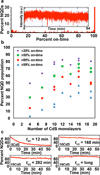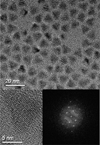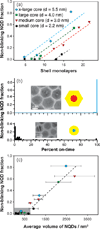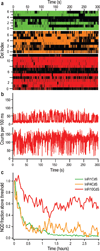Heterostructuring Nanocrystal Quantum Dots Toward Intentional Suppression of Blinking and Auger Recombination
- PMID: 24062602
- PMCID: PMC3778929
- DOI: 10.1021/cm304161d
Heterostructuring Nanocrystal Quantum Dots Toward Intentional Suppression of Blinking and Auger Recombination
Abstract
At the level of a single particle, nanocrystal quantum dots (NQDs) are observed to fluoresce intermittently or "blink." They are also characterized by an efficient non-radiative recombination process known as Auger Recombination (AR). Recently, new approaches to NQD heterostructuring have been developed that directly impact both blinking and AR, resulting in dramatic suppression of these unwanted processes. The three successful hetero-NQD motifs are reviewed here: (1) interfacial alloying, (2) thick or "giant" shells, and (3) specific type-II electronic structures. These approaches, which rely on modifying or tuning internal NQD core/shell structures, are compared with alternative strategies for blinking suppression that rely, instead, on surface modifications or surface-mediated interactions. Finally, in each case, the unique synthetic approaches or challenges addressed that have driven the realization of novel and important functionality are discussed, along with the implications for development of a comprehensive 'materials design' strategy for blinking and AR-suppressed heterostructured NQDs.
Keywords: Auger recombination; alloyed; blinking; core/shell; giant; nanocrystal quantum dots; type II.
Figures












Similar articles
-
New insights into the complexities of shell growth and the strong influence of particle volume in nonblinking "giant" core/shell nanocrystal quantum dots.J Am Chem Soc. 2012 Jun 13;134(23):9634-43. doi: 10.1021/ja212032q. Epub 2012 May 31. J Am Chem Soc. 2012. PMID: 22578279
-
'Giant' multishell CdSe nanocrystal quantum dots with suppressed blinking: Novel fluorescent probes for real-time detection of single-molecule events.Proc SPIE Int Soc Opt Eng. 2009 Mar 3;7189:718904. doi: 10.1117/12.809678. Proc SPIE Int Soc Opt Eng. 2009. PMID: 21804930 Free PMC article.
-
"Giant" multishell CdSe nanocrystal quantum dots with suppressed blinking.J Am Chem Soc. 2008 Apr 16;130(15):5026-7. doi: 10.1021/ja711379k. Epub 2008 Mar 20. J Am Chem Soc. 2008. PMID: 18355011
-
Origin and control of blinking in quantum dots.Nat Nanotechnol. 2016 Aug 3;11(8):661-71. doi: 10.1038/nnano.2016.140. Nat Nanotechnol. 2016. PMID: 27485584 Review.
-
Fundamental Properties in Colloidal Quantum Dots.Adv Mater. 2018 Oct;30(41):e1801442. doi: 10.1002/adma.201801442. Epub 2018 Jun 19. Adv Mater. 2018. PMID: 29923230 Review.
Cited by
-
Composite Supraparticles with Tunable Light Emission.ACS Nano. 2017 Sep 26;11(9):9136-9142. doi: 10.1021/acsnano.7b03975. Epub 2017 Aug 15. ACS Nano. 2017. PMID: 28787121 Free PMC article.
-
The Rise and Future of Discrete Organic-Inorganic Hybrid Nanomaterials.ACS Phys Chem Au. 2022 May 28;2(5):364-387. doi: 10.1021/acsphyschemau.2c00018. eCollection 2022 Sep 28. ACS Phys Chem Au. 2022. PMID: 36855686 Free PMC article. Review.
-
From Inside Out: How the Buried Interface, Shell Defects, and Surface Chemistry Conspire to Determine Optical Performance in Nonblinking Giant Quantum Dots.Small Sci. 2023 Oct 10;3(11):2300092. doi: 10.1002/smsc.202300092. eCollection 2023 Nov. Small Sci. 2023. PMID: 40213516 Free PMC article.
-
Ga for Zn Cation Exchange Allows for Highly Luminescent and Photostable InZnP-Based Quantum Dots.Chem Mater. 2017 Jun 27;29(12):5192-5199. doi: 10.1021/acs.chemmater.7b00848. Epub 2017 Jun 6. Chem Mater. 2017. PMID: 28706347 Free PMC article.
-
Highly bright perovskite light-emitting diodes enabled by retarded Auger recombination.Nat Commun. 2025 Jan 22;16(1):927. doi: 10.1038/s41467-025-56001-x. Nat Commun. 2025. PMID: 39843419 Free PMC article.
References
-
- Leatherdale CA, Woo W-K, Mikulec FV, Bawendi MG. J. Phys. Chem. B. 2002;106:7619.
-
- Jaiswal JK, Mattoussi H, Mauro JM, Simon SM. Nat. Biotechnol. 2003;21:47. - PubMed
-
- Inerbaev TM, Masunov AE, Khondaker SI, Do-brinescu A, Plamadă A-V, Kawazoe Y. J. Chem. Phys. 2009;131:044106. - PubMed
-
- Van Sark WGJHM, et al. J. Phys. Chem. B. 2001;105:8281.
-
- Nirmal M, Dabbousi BO, Bawendi MG, Macklin JJ, Trautman JK, Harris TD, Brus LE. Nature. 1996;383:802.
Grants and funding
LinkOut - more resources
Full Text Sources
Other Literature Sources
Research Materials
